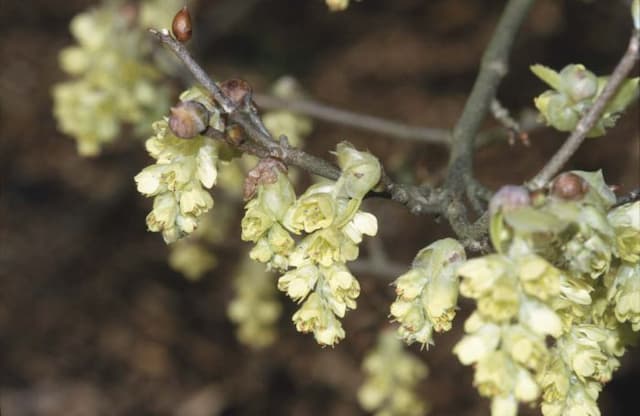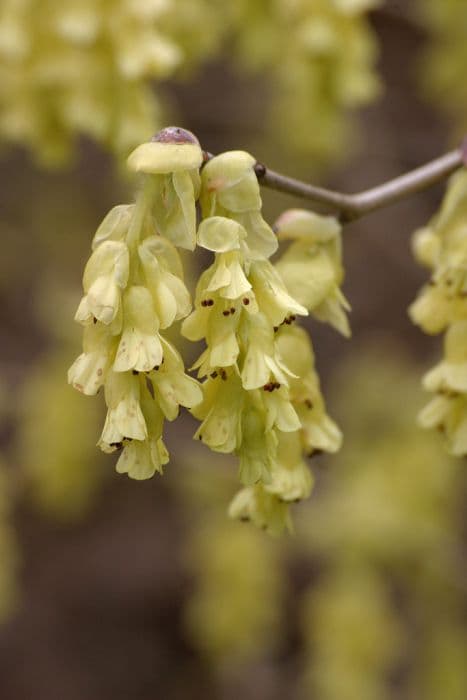Sweetgum Liquidambar styraciflua 'Penwood'

ABOUT
The Liquidambar styraciflua 'Penwood', commonly known as the sweetgum, is a deciduous tree recognized for its attractive foliage and bark. This plant boasts a pyramidal to oval shape that becomes more rounded with age. Its leaves are star-shaped, typically with five pointed lobes, and have serrated edges that create a textured look. During the growing season, the leaves are a glossy green, contributing to a lush appearance. In the fall, sweetgum becomes especially showy as its leaves transform into a kaleidoscope of vibrant colors, ranging from yellow and orange to red and purple. The bark is grayish and deeply furrowed, adding a rugged texture to the landscape even in winter when the tree is leafless. The sweetgum produces spiky fruit, colloquially termed "gumballs," which hang from the branches and provide a unique visual interest, though they can be a nuisance when they fall to the ground. The tree's branching pattern is dense and symmetrical, offering a pleasing silhouette throughout the year.
About this plant
 Names
NamesSynonyms
American Sweetgum, Redgum, Sweetgum, Satin-walnut, Star-leaved Gum, Alligatorwood, Bilsted.
Common names
Liquidambar styraciflua.
 Toxicity
ToxicityTo humans
The Liquidambar styraciflua, commonly known as Sweetgum, is generally not considered toxic to humans. There are no well-documented cases of poisoning from ingesting parts of this plant. However, as with any non-food plant material, it is possible that some individuals may experience mild stomach discomfort if any parts of the plant are ingested, due to the presence of plant compounds that humans are not accustomed to consuming.
To pets
Sweetgum is also not known to be toxic to pets. It is not listed as a poisonous plant for pets by major animal health organizations. However, ingestion of non-food items can potentially lead to gastrointestinal upset in pets, like vomiting or diarrhea, simply as a result of ingesting something unusual. If your pet has ingested part of a Sweetgum plant and is displaying symptoms, it is recommended to consult a veterinarian.
 Characteristics
CharacteristicsLife cycle
Perennials
Foliage type
Deciduous
Color of leaves
Green
Height
60 70 feet (18 21 meters)
Spread
40 50 feet (12 15 meters)
Plant type
Tree
Hardiness zones
5 9
Native area
Americas
Benefits
 General Benefits
General Benefits- Ornamental Value: Sweetgum 'Penwood' is renowned for its beautiful, star-shaped leaves and striking fall colors ranging from yellow to red and purple.
- Shade Provider: With its broad canopy, it offers substantial shade in the summer, making it an excellent tree for parks and large gardens.
- Wildlife Habitat: Sweetgum 'Penwood' can serve as a habitat and source of food for various birds and small mammals.
- Soil Stabilization: Its extensive root system helps to prevent soil erosion, especially on slopes or in areas susceptible to erosion.
- Carbon Sequestration: As a large deciduous tree, it plays a role in capturing atmospheric carbon dioxide, helping to mitigate climate change.
- Seasonal Interest: It has year-round interest with attractive budding in the spring, lush greenery in the summer, colorful autumn foliage, and interesting seed pods in the winter.
- Wood Production: While not its primary use in landscaping, sweetgum wood is valuable for timber and furniture making.
 Medical Properties
Medical Properties- Antibacterial: Liquidambar styraciflua, commonly known as American sweetgum, has been studied for its antibacterial properties, particularly present in its resin.
- Anti-inflammatory: The plant's resin and bark are believed to have anti-inflammatory effects.
- Antioxidant: Extracts from American sweetgum may contain antioxidant components beneficial for health.
 Air-purifying Qualities
Air-purifying QualitiesThis plant is not specifically known for air purifying qualities.
 Other Uses
Other Uses- Woodworking: The wood of the sweetgum is valued for its grain and ease of working which makes it ideal for fine woodworking projects such as furniture, cabinetry, and interior trim.
- Amateur Perfumery: Due to its aromatic properties, sweetgum resin may be used by amateur perfumers in making homemade scents and incenses.
- Craft Materials: The spiny seed pods, often called "gumballs," can be collected and used in craft projects like wreath-making or as natural Christmas ornaments.
- Photography Prop: The striking fall foliage of the sweetgum provides an excellent backdrop for autumn-themed photography shoots.
- Wildlife Habitat: Sweetgum trees can act as a habitat and food source for various bird species, who feed on the seeds found in its spiky fruit.
- Natural Dye: The leaves, bark, and roots can be used to create natural dyes for textiles, with color outcomes varying from yellow to brown.
- Soil Stabilization: Due to its extensive root system, sweetgum trees can be planted to help stabilize soil and prevent erosion in certain areas.
- Educational Tool: As a native species with distinct seasonal changes, sweetgum is ideal for use in educational settings to teach about plant life cycles and ecology.
- Landscape Design: Sweetgum trees, with their symmetrical shape and ornamental value, are often used in landscape design for aesthetic purposes such as focal points in gardens.
- Culinary Experimentation: While not traditionally consumed, the resin-like sap called "styrax" was historically used as a flavoring agent and can be experimentally infused in syrups or spirits for unique culinary creations.
Interesting Facts
 Feng Shui
Feng ShuiThe Sweetgum tree is not used in Feng Shui practice.
 Zodiac Sign Compitability
Zodiac Sign CompitabilityThe Sweetgum is not used in astrology practice.
 Plant Symbolism
Plant Symbolism- Beauty: The Sweetgum, with its star-shaped leaves and striking fall colors, often symbolizes beauty and the changes of life.
- Change: As a deciduous tree showcasing a dramatic color transformation in autumn, the Sweetgum represents change and adaptability.
- Longevity: Sweetgums can live for a very long time, making them a symbol of endurance and stability.
- Healing: Historically, the resin of Sweetgum, known as storax, has been used for medicinal purposes, which can symbolize healing and protection.
 Water
WaterFor the Sweetgum tree, it's essential to establish a deep and thorough watering routine, especially during the first few growing seasons. After planting, water Sweetgums with about 5 gallons of water once a week, ensuring that moisture reaches deep into the soil to encourage a strong root system. Once established, the frequency can be reduced, relying on rainfall and only providing supplemental water during prolonged dry spells. Be careful not to overwater as Sweetgums do not like waterlogged soil. A good rule of thumb is to water every two to three weeks if there has been no significant rainfall, adjusting as necessary for your specific climate conditions.
 Light
LightSweetgum trees thrive in full sun, meaning they require at least six hours of direct, unfiltered sunlight each day to perform their best. Planting in an area where they can receive plenty of sunlight throughout the day will ensure optimal growth and development. These trees can tolerate partial shade, but their fall color and overall vitality are maximized in full sun conditions.
 Temperature
TemperatureSweetgum trees are quite adaptable and can tolerate a wide range of temperatures, thriving in USDA Hardiness Zones 5 through 9. They can handle temperatures well below freezing in winter, down to around -10°F, and can endure summer temperatures well into the 90s°F. For ideal growth, maintain the environment within this temperature range, avoiding extremes to prevent stress on the tree.
 Pruning
PruningPrune Sweetgum trees to maintain their shape, remove any damaged or diseased branches, and encourage healthy growth. The best time for pruning is in late winter or early spring before new growth begins. Prune as necessary to remove dead wood or to thin out crowded branches, but it's typically not required annually. Be cautious not to over prune, as this can stress the tree and cause more harm than good.
 Cleaning
CleaningAs needed
 Soil
SoilSweetgum prefers a rich, moist, well-drained loamy soil with a pH of 5.5 to 7.5. To create the best soil mix for sweetgum, combine garden soil, compost, and peat moss in equal parts to ensure fertility and proper drainage.
 Repotting
RepottingSweetgum trees, being large and primarily outdoor trees, do not require regular repotting. They should be planted in a permanent location where they can grow undisturbed.
 Humidity & Misting
Humidity & MistingSweetgum trees are adaptable to various humidity levels but thrive best in moderate to high humidity typical of outdoor environments.
 Suitable locations
Suitable locationsIndoor
Sweetgum isn't suited for indoor growth; needs ample space.
Outdoor
Plant in full sun, moist soil, and allow for significant growth.
Hardiness zone
5-9 USDA
 Life cycle
Life cycleThe life cycle of the Sweetgum (Liquidambar styraciflua 'Penwood') begins with germination, where seeds sown in the ground sprout when exposed to appropriate temperatures and moisture levels. Seedlings emerge and gradually develop into juvenile plants, exhibiting rapid growth and the development of characteristic palmate leaves. As it matures, the Sweetgum enters its reproductive phase, producing distinctive spiky fruiting balls after flowering, which occurs in the spring. Over many years, the tree reaches full maturity, showcasing a tall, pyramidal form with a thick, fissured bark. After reaching maturity, the tree has an extended period of stability during which it continues to grow slowly and reproduce annually. The life cycle concludes as the tree eventually senesces and dies, returning nutrients to the soil through decomposition.
 Propogation
PropogationPropogation time
Early Spring
The most popular method of propagation for Sweetgum, specifically the Liquidambar styraciflua 'Penwood', is by seed. Sweetgum seeds require a period of cold stratification to break dormancy, which can be achieved by mixing the seeds with moist sand and refrigerating them at 40 degrees Fahrenheit (4.4 degrees Celsius) for 1 to 3 months. After stratification, the seeds are sown in well-drained soil in a sunny location, either in the fall or in the spring after the last frost has passed. The soil should be kept consistently moist until germination, which may take a few weeks. Seedlings are generally ready to be transplanted to their permanent location after one growing season.









